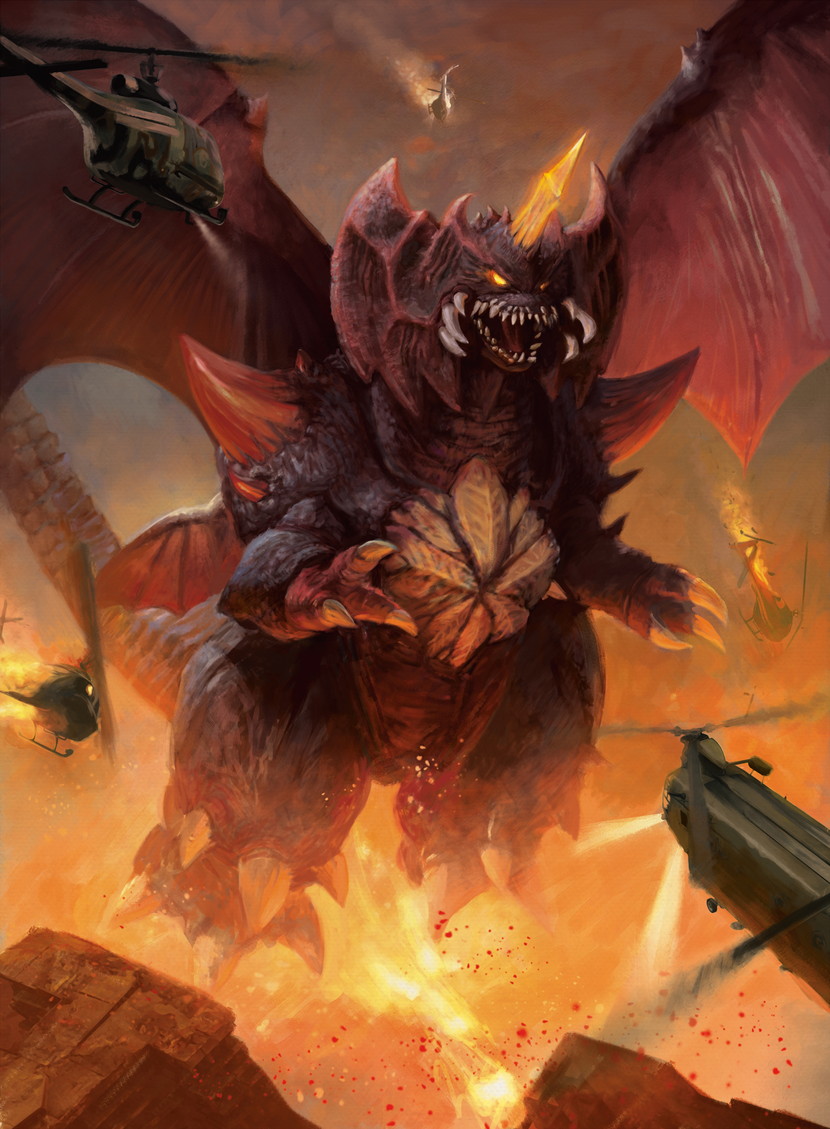Lore fans and Godzilla's Witnesses, I'm back after a bit of a hiatus with an exciting slate of articles in the works. I'll dive into flavor gems in my next article, but my first article back I wanted to touch on a subject close to my heart. Fans of Magic: the Gathering were in for a surprise treat during Ikoria preview season, as Wizards of the Coast revealed the Godzilla Series featuring Toho monsters. For those of you unfamiliar with giant monster films, Toho Co., Ltd. is the owner of the Godzilla franchise and the dozens of monsters associated with it. Today's article is all about one of my greatest passions outside of Magic - the King of Monsters, Godzilla.
For Godzilla Fans: The Magic of Card Games
Just in case we get some Godzilla fans unfamiliar with Magic: the Gathering wandering in here, Wizards of the Coast is a game company primarily known for the aforementioned card game and the tabletop RPG Dungeons & Dragons. Magic typically releases about four 'Standard' sets a year, and this year's spring card set takes place on a brand-new monster world called Ikoria. While Ikoria is heavily influenced by monster franchises big and small, from Godzilla to Monster Hunter to Pokemon, the biggest and most powerful cards this time around are all giant monster themed. Wizards of the Coast licensed Godzilla to use as promotional versions of existing creature cards.

Godzilla, King of the Monsters (Zilortha, Strength Incarnate) by Antonio José Manzanedo
For Magic Fans: A Monster of a Primer
Toho's giant monsters (called kaiju, meaning strange creature) are an early example of a shared universe, long before it became the norm with western franchises. There are a whopping 32 Japanese Godzilla films and four American films (not including the Raymond Burr versions of the original and Godzilla 1985, which are effectively different films with American footage spliced in), and that's only counting the films Godzilla stars in - some of the other monsters have their own solo movies. This huge filmography makes Godzilla a larger and longer running franchise than even its closest competitor, James Bond (whose paltry 25th entry comes out this year).
Godzilla films are generally divided into four eras: Showa, Heisei, Millennium, and Reiwa. Each era typically has its own continuity but usually share the original in their canon (although the Millennium films are largely independent of one another). There has generally been about a five to ten year gap between eras, as Toho gives the franchise an opportunity to breathe and renew interest for the next. Godzilla himself has gotten a redesign with every era, and while the suit itself often changed between films the Godzilla of each era is largely recognizable in overall design.
The Showa era is what most people would think of as classic Godzilla, everything from the original Godzilla (1954) through the 60s and 70s films. The Heisei Era is my personal favorite, from Godzilla Returns (or Godzilla 1985) through Godzilla vs Destroyah (1995) and is what most of the designs you'll see in the Godzilla Series are based on. The Millennium Era is notable for the introduction of CG effects and the overall lack of continuity between films (with limited exceptions), which includes films from Godzilla 2000 (1999) through Godzilla: Final Wars (2004) (the Time Spiral of Godzilla films). The Reiwa era is the modern era, with Shin Godzilla (2016) and the all-cg Netflix films as the only current entries.
The Legendary Monsterverse, which currently includes Godzilla (2014), Kong: Skull Island (2017), and Godzilla: King of the Monsters (2019), is likely the inspiration for this crossover, as Ikoria: Lair of the Behemoths was originally going to launch alongside Godzilla vs Kong (2020). The delay of the newest Monsterverse film is disappointing, especially in light of Ikoria's grand surprise, but perhaps a stroke of luck for the film to avoid a COVID-19-related box office fiasco. If you want a single Godzilla movie recommendation to watch as a newcomer, you can't go wrong with Godzilla: King of the Monsters, which features three of the major Godzilla monsters and does a fantastic job capturing the spirit of all the Japanese films with the budget and effects of a Hollywood Blockbuster.
I'm not going to list every Godzilla film that one of the Godzilla Series monsters appeared in, for that you should check out the Godzilla (franchise) page on Wikipedia. Oh, and if you're looking for film recommendations, I put some together last year in advance of the previous Monsterverse film. Be sure to check it out!
Someone on @TheVorthosCast Discord asked what Godzilla movies are worth seeing if they're interested in Godzilla: King of the Monsters.
— Jay Annelli (@jay13x) May 8, 2019
There's a bunch, and you have to go into them knowing they're campy, but they're a lot of fun. Here's my list.
The Toho Monsters
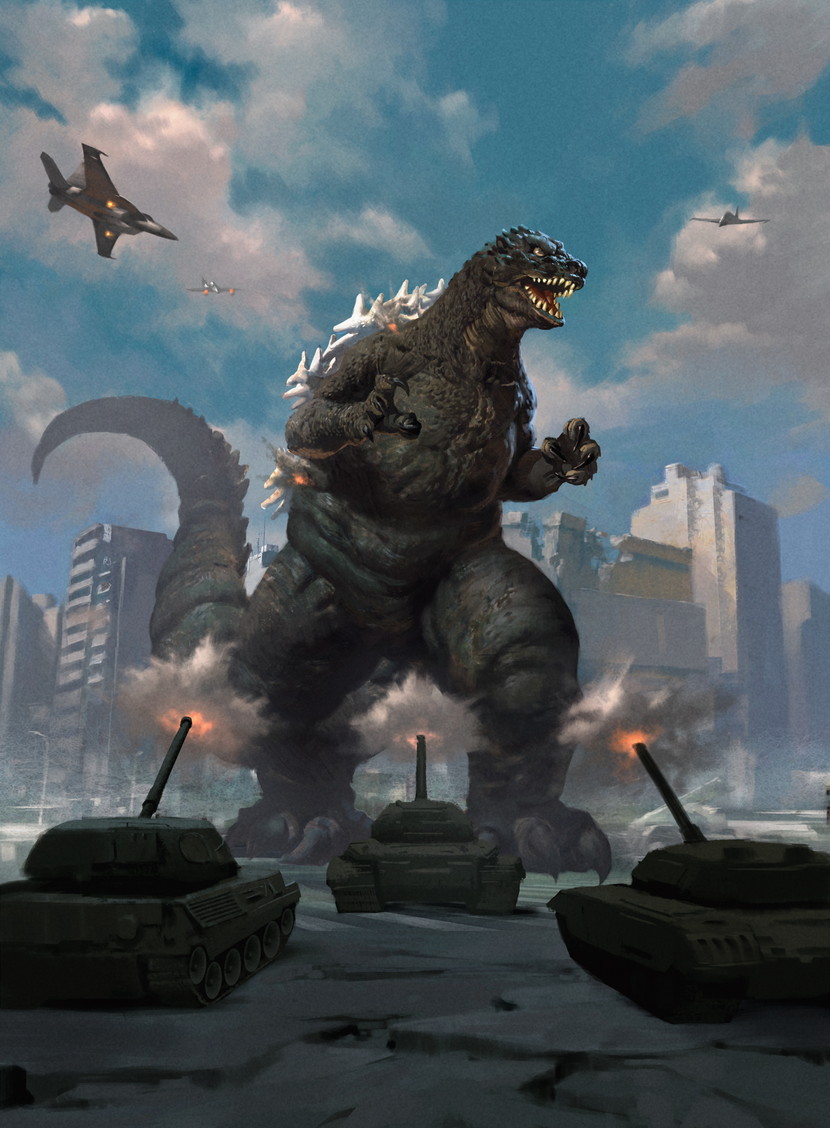
Godzilla, Primeval Champion (Titanoth Rex) by Lius Lasahido
Godzilla
Cards: Godzilla, King of the Monsters (Zilortha, Strength Incarnate); Godzilla, Primeval Champion (Titanoth Rex), Godzilla, Doom Inevitable (Yidaro, Wandering Monster)
Notable Appearances: Godzilla (1954), Return of Godzilla (1984), Godzilla vs. Biollante (1989), Godzilla vs. King Ghidora (1991), Godzilla vs. Mothra (1992), Godzilla vs. Mechagodzilla II (1993), Godzilla vs. SpaceGodzilla (1994), Godzilla vs. Destroyah (1995), Shin Godzilla (2016)
The big G himself, Godzilla was originally conceived as an allegory for nuclear war. Released less than a decade after the first atom bomb was dropped on Japan, the film tackled the enormity of weapons of mass destruction. Later films shifted the allegory from nuclear proliferation to nuclear power and industrial pollution, and some didn't try at all. Thanks to the radioactive energy that empowers him, Godzilla is known for an atomic breath attack that causes his dorsal plates to glow with energy.
The origin of Godzilla himself changes between eras: is he just a deep-sea creature awoken by atomic testing? Is he a dinosaur or iguana mutated by radiation? Is he the avatar of the vengeful souls of those who died in World War II? There are at least a half-dozen different Godzilla origins out there, but whatever the reason for Godzilla, he's always a big lizard-like creature with huge dorsal plates. Godzilla has also run the gamut from villain to hero, depending on the film.
The version of Godzilla we see most here is Heisei Godzilla. He's my personal favorite, running for a total of seven films with direct continuity. This version of Godzilla was once a Godzillasaurus (no, really) who was mutated by the radiation from atomic testing. This version of Godzilla was portrayed as a wild animal with a heroic bent (or at least the lesser of two evils in most films).
We also get a card representing the horror of Shin Godzilla, which was created by Hideaki Anno. This version of Godzilla mutates and adapts to whatever weapons humanity throws against it, returning bigger and stronger every time. If you've followed Anno's other works (like Evangelion) you know what to expect, it's not pretty.
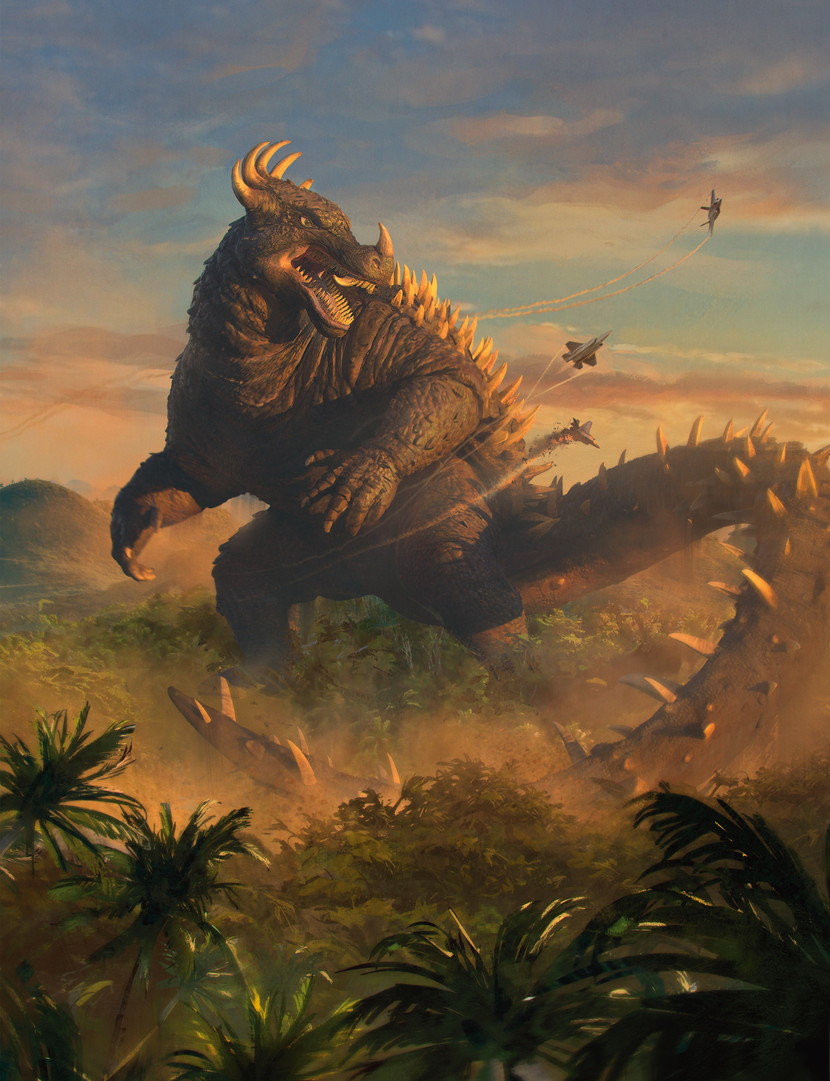
Anguirus, Armored Killer (Gemrazer) by Sam Rowan
Anguirus
Cards: Anguirus, Armored Killer (Gemrazer)
Notable Appearances: Godzilla Raids Again (1955), Godzilla: Final Wars (2004)
Anguirus is Godzilla's first antagonist, starring in the second Godzilla film ever made. Despite appearing in many Showa era films, he's only appeared in one film since the 1970s. Anguirus himself is an irradiated dinosaur, like most versions of Godzilla, but vaguely resembles an ankylosaurus. He went back and forth as an ally and antagonist of Godzilla's, the version of Anguirus we see here is a remix of his classic appearance and Godzilla Final Wars. I wish I had more time to devote to Anguirus, but much like Toho, I have more interesting monsters to move on to.
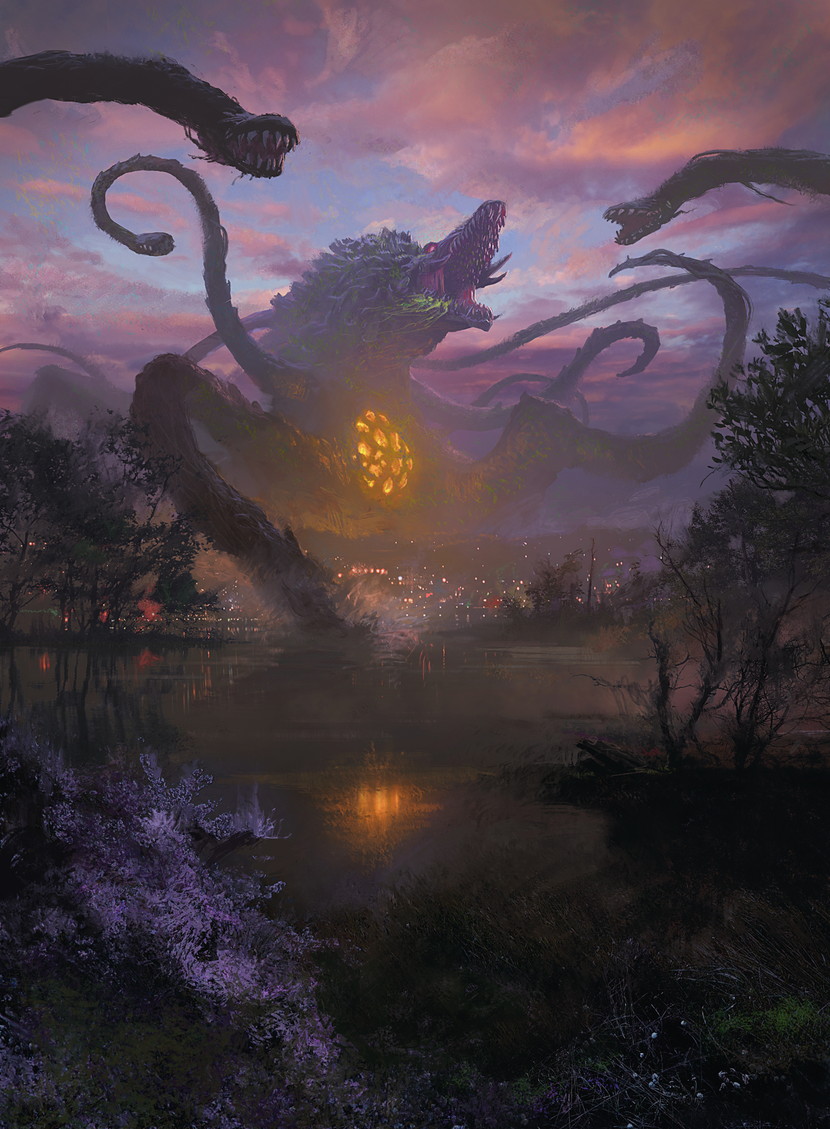
Biollante, Plant Beast Form (Nethroi, Apex of Death) by Torstein Nordstrand
Biollante
Cards: Biollante, Plant Beast Form (Nethroi, Apex of Death)
Notable Appearances: Godzilla vs. Biollante (1989)
Biollante is what happens when you splice Godzilla DNA with human and plant genes. The scientist who created Biollante had created a hybrid rose with the DNA of his psychic daughter, but when it was destroyed he used G-Cells (Godzilla's cells) to make the hybrid immortal. The resulting creature grew out of control until it began to resemble Godzilla (the version we see in the art). The character was born of genetic engineering panic of the 80's and 90's, and is strange even for a Godzilla plot. Although she only stars in one film, Biollante is a rather infamous addition to the Godzilla rogues gallery. Whether that's infamous in a good way or bad way depends on who you're talking to. Oh, and it gets more convoluted, as you'll see in a moment.
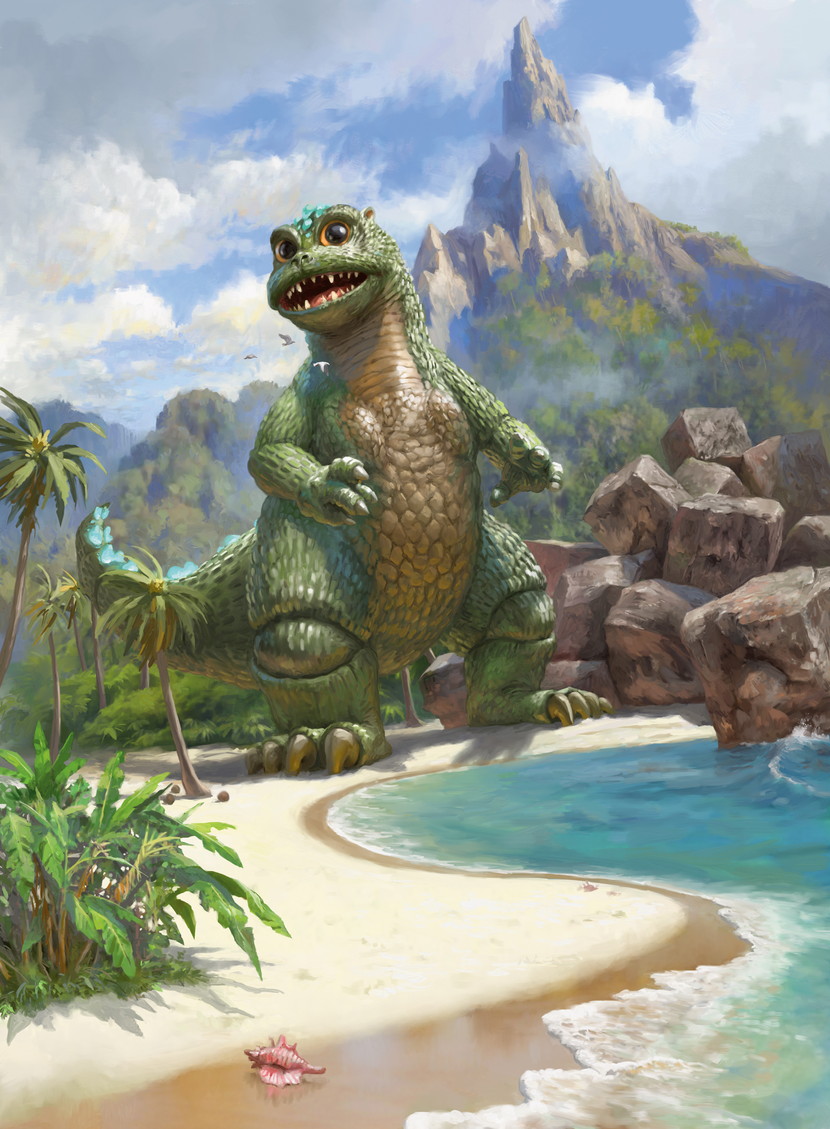
Babygodzilla, Ruin Reborn (Pollywog Symbiote) by Simon Dominic
Babygodzilla
Cards: Babygodzilla, Ruin Reborn (Pollywog Symbiote)
Notable Appearances: Godzilla vs. Mechagodzilla II (1993), Godzilla vs. SpaceGodzilla (1994), Godzilla vs. Destroyah (1995)
Godzilla has had a few offspring with different names over the years. You might recognize the name Minilla from the Showa Era, or if you're a fan of Hanna-Barbera Cartoons, Godzooky. Babygodzilla is the Heisei iteration of these characters, although its name and look changes with each film it appears in. The original version is Baby Godzilla, then in the next film it is Little Godzilla, and finally Godzilla Jr. The art here is actually Little Godzilla, the second form from Godzilla vs Spacegodzilla. The first form is actually closer in appearance to a regular dinosaur, while this version resembles the classic Showa iteration called Minilla. This version appeared in Godzilla vs. SpaceGodzilla, where he was promptly kidnapped by Spacegodzilla for Spacegodzilla reasons. In the following film as Godzilla Junior, he's a chip off the old plutonium block and is literally just a small version of Godzilla. This cutie pie eventually succeeds his dad when his parent dies after his battle with Destroyah.
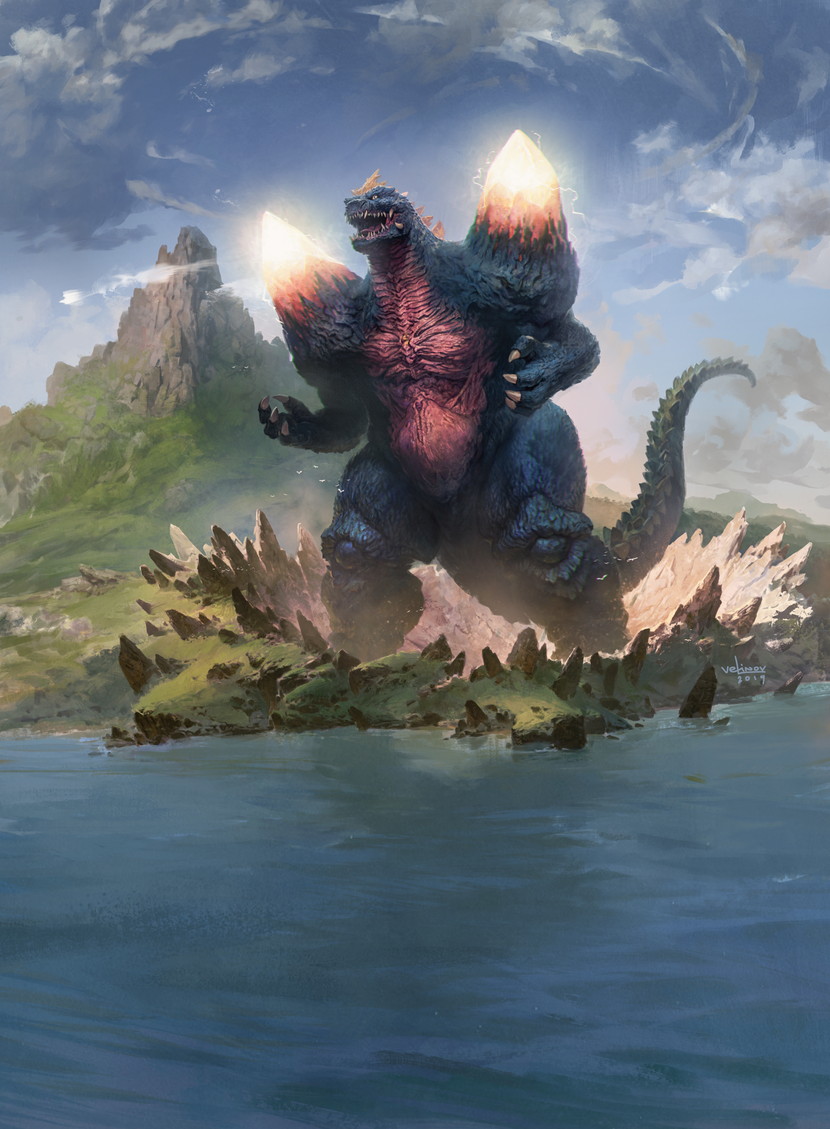
Bio-Quartz Spacegodzilla (Brokkos, Apex of Forever) by Svetlin Velinov
SpaceGodzilla
Cards: Bio-Quartz Spacegodzilla (Brokkos, Apex of Forever); Spacegodzilla, Void Invader (Void Beckoner)
Notable Appearances: Godzilla vs SpaceGodzilla (1994)
Spacegodzilla is, essentially, a space clone of Godzilla. In case that wasn't obvious. Two theories are presented in Godzilla vs SpaceGodzilla about how this happened. The first is that when Biollante was destroyed at the end of Godzilla vs. Biollante, it disintegrated into spores that were blown into space. The other is that these cells are ones from a battle with Mothra and Battra in Godzilla vs. Mothra that were blown into space. The former is more likely correct, as Spacegodzilla shares design elements with Biollante (like tusks) and has psychic powers (like the girl spliced into Biollante).
Regardless, the g-cells, blowing through the void, were exposed to the radiation of a black hole. In the vacuum of space they grew and mutated until evil SpaceGodzilla was born, who promptly returned to earth and kidnapped Godzilla's offspring with its telekinetic powers. Spacegodzilla is only defeated when Godzilla teams up with a human-piloted giant mech suit called M.O.G.U.E.R.A. Despite only appearing in one film, SpaceGodzilla is one of the most infamous Godzilla monsters, due to both the silly name and memorable design work. Spacegodzilla would feel at home on Ikoria, thanks to its affinity for crystals, a design feature that is ubiquitous on Ikoria.
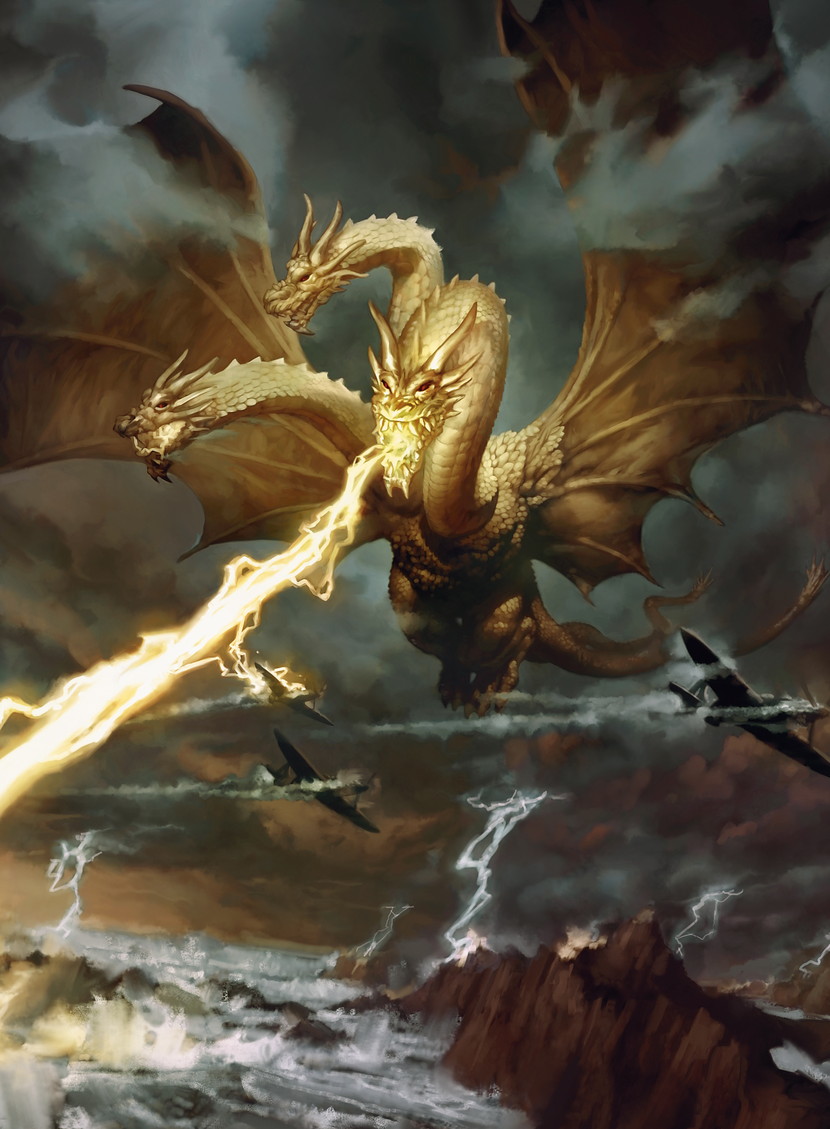
Ghidora, King of the Cosmos (Illuna, Apex of Wishes) by Nicholas Gregory
King Ghidora & the Dorats
Cards: Ghidora, King of the Cosmos (Illuna, Apex of Wishes); Dorat, the Perfect Pet (Sprite Dragon)
Notable Appearances: Ghidora, the Three-Headed Monster (1964), Godzilla vs. King Ghidorah (1991)
The Joker is to Batman what King Ghidora is to Godzilla. Appearing in about 7 of the Japanese Godzilla films (and notably last year's Godzilla: King of the Monsters), King Ghidora has been an alien weapon, a noble ancient spirit to protect Japan, and a time-traveling weapon from the future. The King of the Cosmos here has some pretty dated war planes, which would push it back to the Showa era, but the design seems like the Heisei version, which had longer and straighter horns on each head. And, uh, is a lot less silly looking. King Ghidora is known for attacking with a lightning beam attack from his three mouths.
In the Heisi version of King Ghidora, bad people from the future trick the Japanese government into going back in time with them and moving the dinosaur that would become Godzilla (dubbed Godzillasaurus... yes, really) from the island where he would be irradiated. Secretly, they leave behind three cute creatures called Dorats that are mutated in Godzilla's place, birthing King Ghidora. King Ghidora is only stopped when Godzilla reappears, having attacked a nuclear submarine and been created anyway, bigger and stronger than ever. This version of King Ghidora is killed, but is rebuilt with cyborg technology from the future to become Mecha King Ghidora. Mecha King Ghidora drives Godzilla away from Japan before returning to the future.
And yes, Godzilla plots are essentially mad libs.
Godzilla lore is Madlibs
— Syr Wilhelm Kenrith (@HairlessThoctar) April 2, 2020
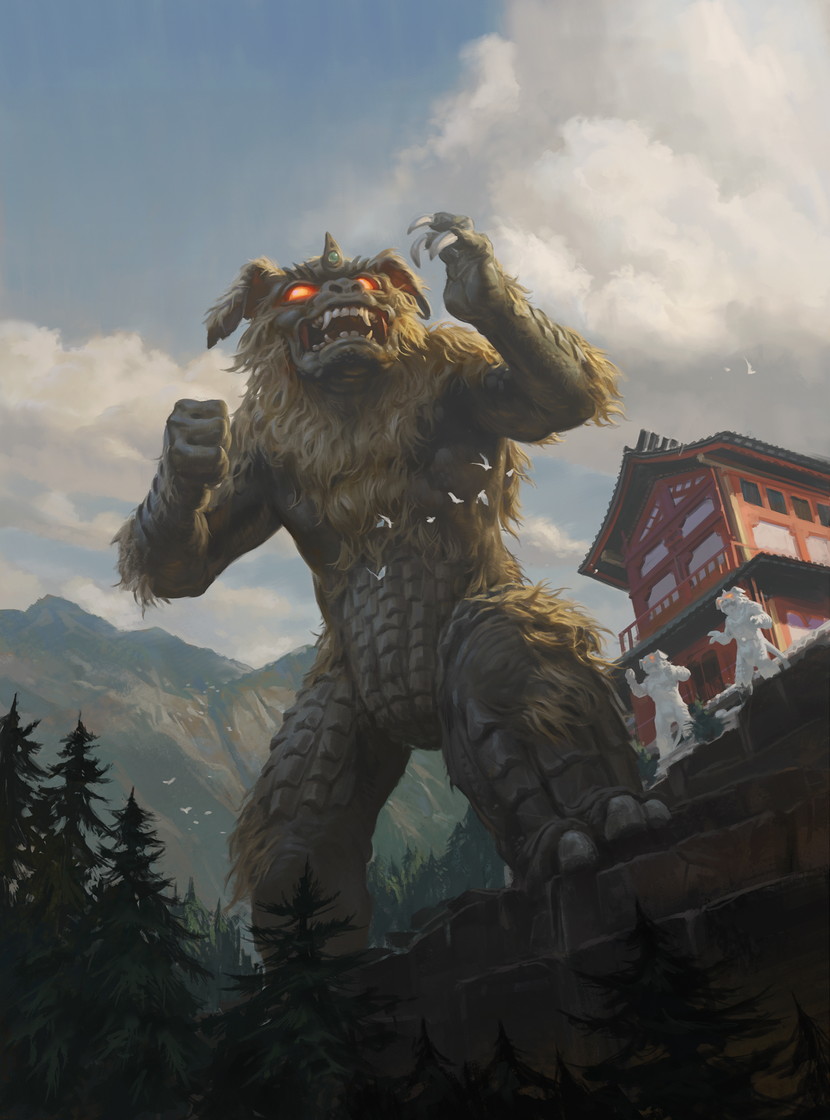
King Caesar, Ancient Guardian (Huntmaster Liger) by Slawomir Maniak
King Caesar
Cards: King Caesar, Awoken Tyrant (Snapdax, Apex of the Hunt); King Caesar, Ancient Guardian (Huntmaster Liger)
Notable Appearances: Godzilla vs. Mechagodzilla (1974), Godzilla: Final Wars (2004)
King Caesar is a minor Godzilla monster, originally appearing as a guardian deity awakened to aid Godzilla against Mechagodzilla (the original one). The version of King Caesar we see on the card here is the updated design resembling the one from Godzilla: Final Wars, where King Caesar is largely relegated to a montage of monsters attacking the globe. King Caesar is a monster based on stone lion statues called Shisa from Okinawa, and has an entirely too long song dedicated to waking him up.
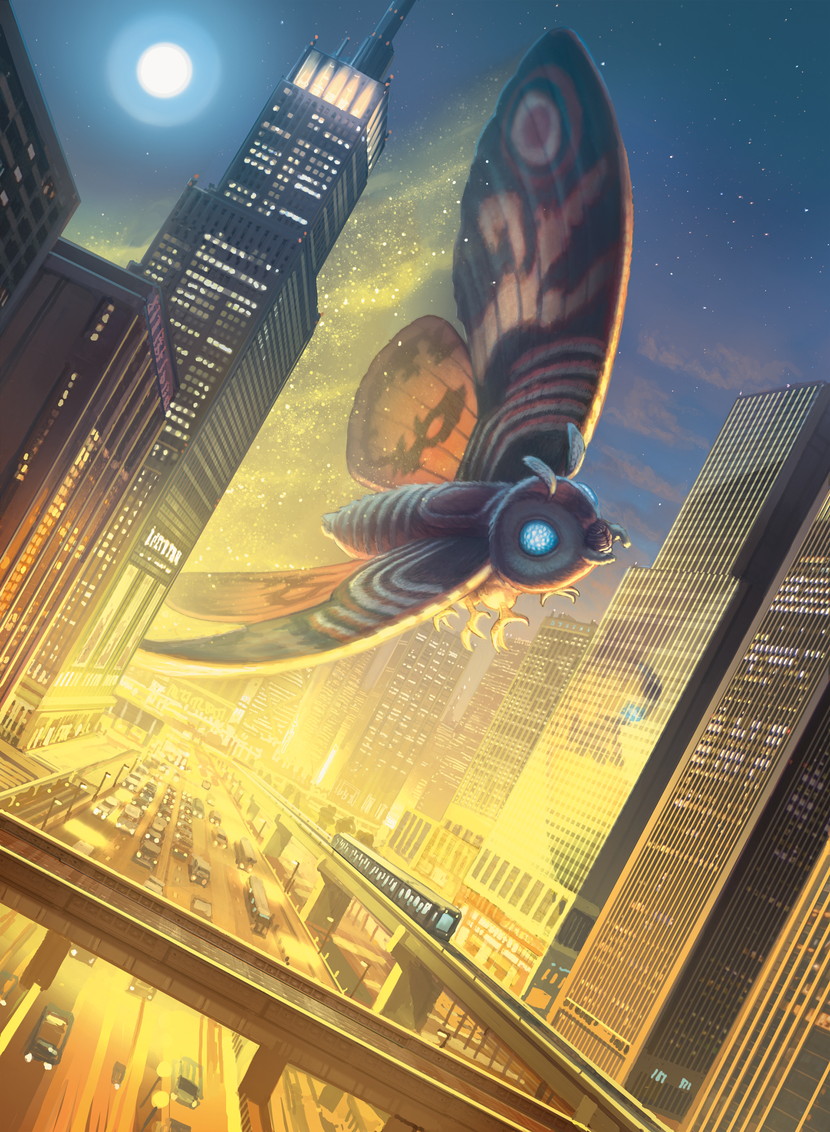
Mothra, Supersonic Queen (Luminous Broodmoth) by Nick Southam
Mothra
Cards: Mothra, Supersonic Queen (Luminous Broodmoth), Mothra's Great Cocoon (Mysterious Egg)
Notable Appearances: Mothra (1961), Godzilla vs. Mothra (1992)
Mothra is considered one of the core Godzilla characters, having appeared in every era of film and more solo appearances than anyone save Godzilla (having four films of her own). She is also the only monster besides Godzilla that is heavily embedded in the cultural zeitgeist - most people know at least vaguely who Mothra is. Mothra is the only Godzilla monster that is unambiguously heroic in pretty much all of her incarnations. Worshipped as a diety by the inhabitants of Infant Island, incarnations of Mothra hatch from giant eggs in a larval form. They usually get beat up a lot as larvae, so they spin a cocoon and pupate into their final Mothra form (seen on Mysterious Egg). In the Heisei continuity, one of the Mothra eggs is corrupted and becomes an ugly, evil version of Mothra called Battra. I'll talk about that one soon.
There have been a lot of Mothras over the years, despite her popularity she's consistently one of the weaker monsters, usually there to give the protagonist an edge against the antagonist... and frequently dying in the process. Her design and origin is pretty consistent throughout the films, down to twin miniature women who act as her guardians and ambassadors. They also get kidnapped a lot, because they're doll-sized and people suck. In the new Legendary film, these twins are referenced by the twins that run in Dr. Cheng and Dr. Ling's family.
The larger head of this artwork indicates a Showa or Heisei version of the character. The Millenium version had a smaller head, and the Legendary Version had the most radical redesign with a small body and long legs. One last note: fans of the Legendary Monsterverse might now be aware that Mothra has her own iconic theme song (this specific one taken from the Rebirth of Mothra series):
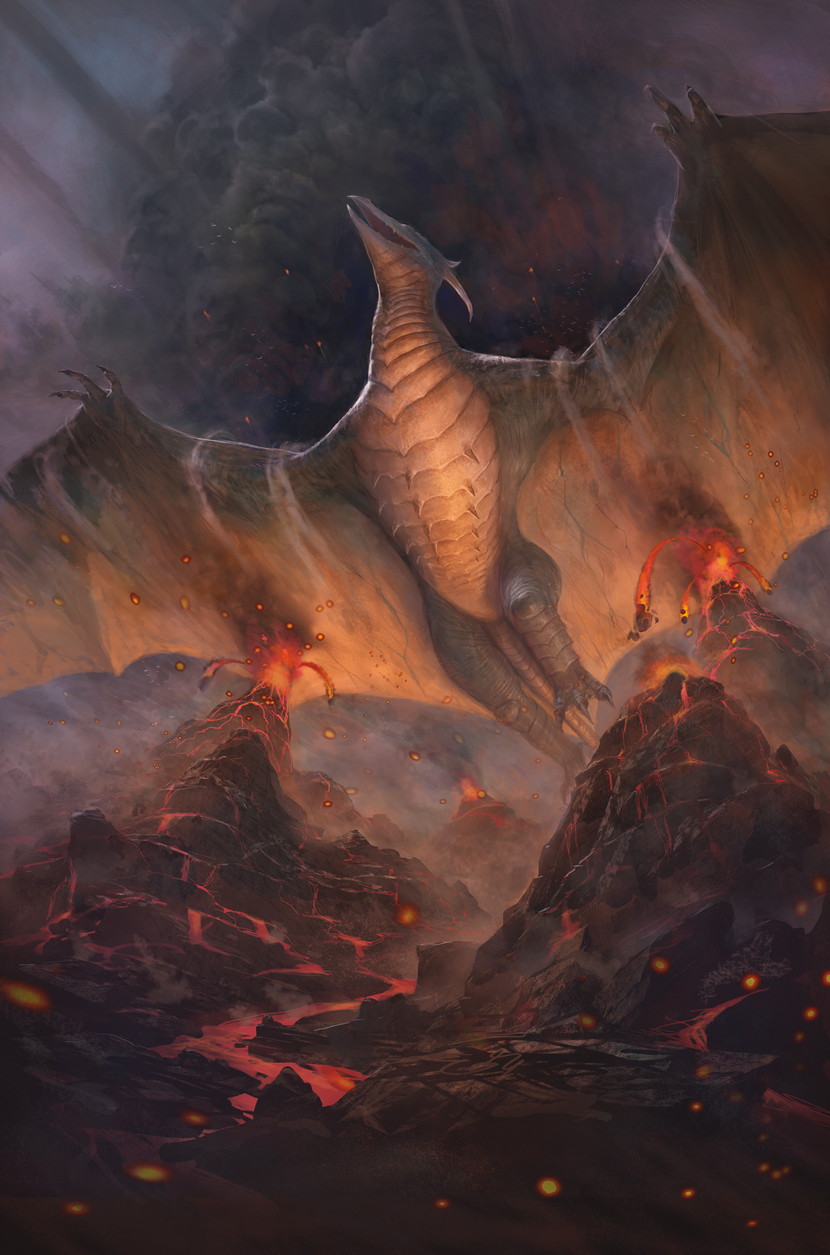
Rodan, Titan of Winged Fury (Vadrox, Apex of Thunder) by Johann Bodin
Rodan
Cards: Rodan, Titan of Winged Fury (Vadrox, Apex of Thunder)
Notable Appearances: Rodan (1956), Godzilla vs. Mechagodzilla II (1993)
One of my friends likes to refer to Rodan as the hot mess kaiju, and honestly it's the best descriptor for him. The Pteranodon monster was one of Toho's first follow-ups to the success of Godzilla, and much as he might try, Rodan just can't seem to catch a break. Vacillating between protagonist and antagonist over his various appearances, he's usually there to get beat up or act as a crony to more powerful monsters. Rodan didn't even have a beam attack at first, like the more popular monsters did. That would get added in the Heisei version of Rodan, who got a heat beam and the moniker Fire Rodan.
Rodan's origin usually involves being dormant in a volcano of some kind. In Godzilla: King of the Monsters, they took this one step further and made him almost volcanic himself. Rodan's design has been pretty consistent, being the monster most closely based on a real dinosaur. This artwork, like most in the Godzilla Series, is clearly based on the Hesei version.
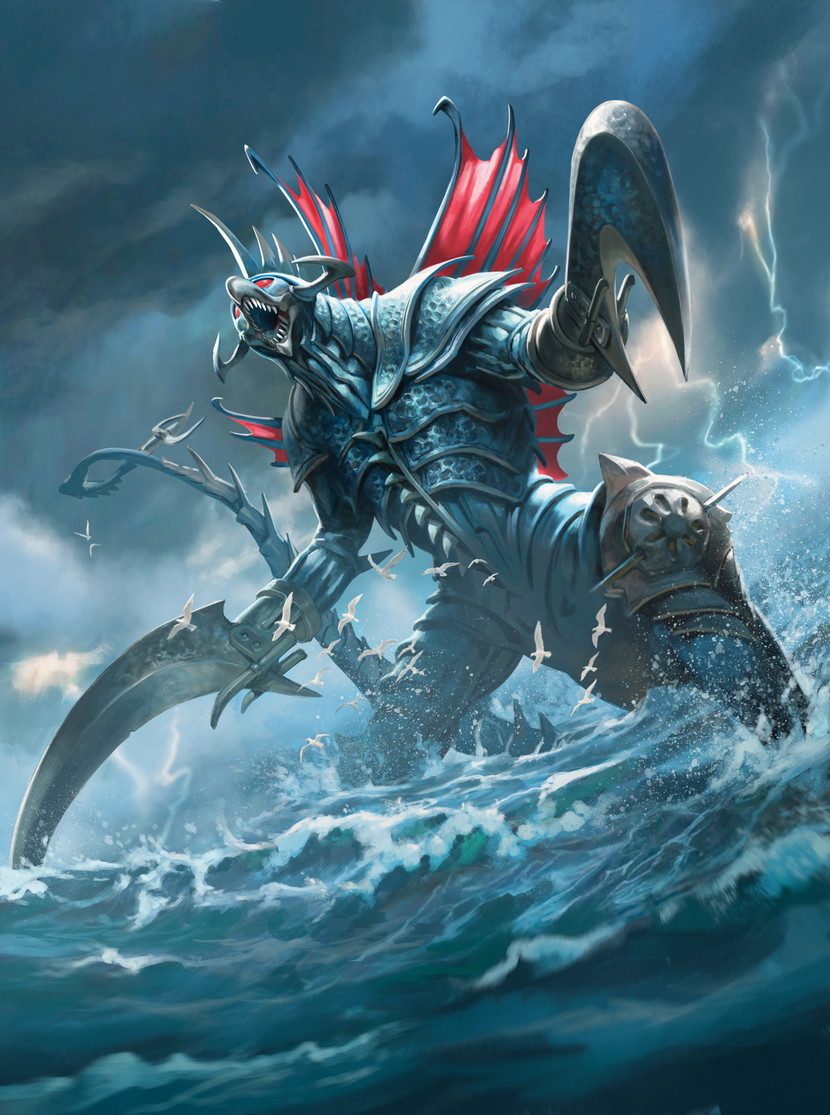
Gigan, Cyberclaw Terror (Gyruda, Doom of Depths) by Jesper Ejsing
Gigan
Cards: Gigan, Cyberclaw Terror (Gyruda, Doom of Depths)
Notable Appearances: Godzilla vs Gigan (1972), Godzilla vs Megalon (1973), Godzilla: Final Wars (2004)
Gigan is probably one of the more out-there Godzilla monsters, armed with metal hooks for hands and a buzzsaw chest. The cyclopean insect-thing is an alien weapon unleashed alongside the space monster version of King Ghidora. The version of Gigan we get on Gigan, Cyberclaw Terror is the modern design from Godzilla: Final Wars (like all the monsters here that didn't appear in the Heisei era). In that version, Gigan was significantly streamlined from a slightly chubby gold and green monster with stubby hooks to a muscular black monster with longer, deadlier-looking scythes. This latter version loses his scythe arms in battle and they're replaced by double-chainsaws.
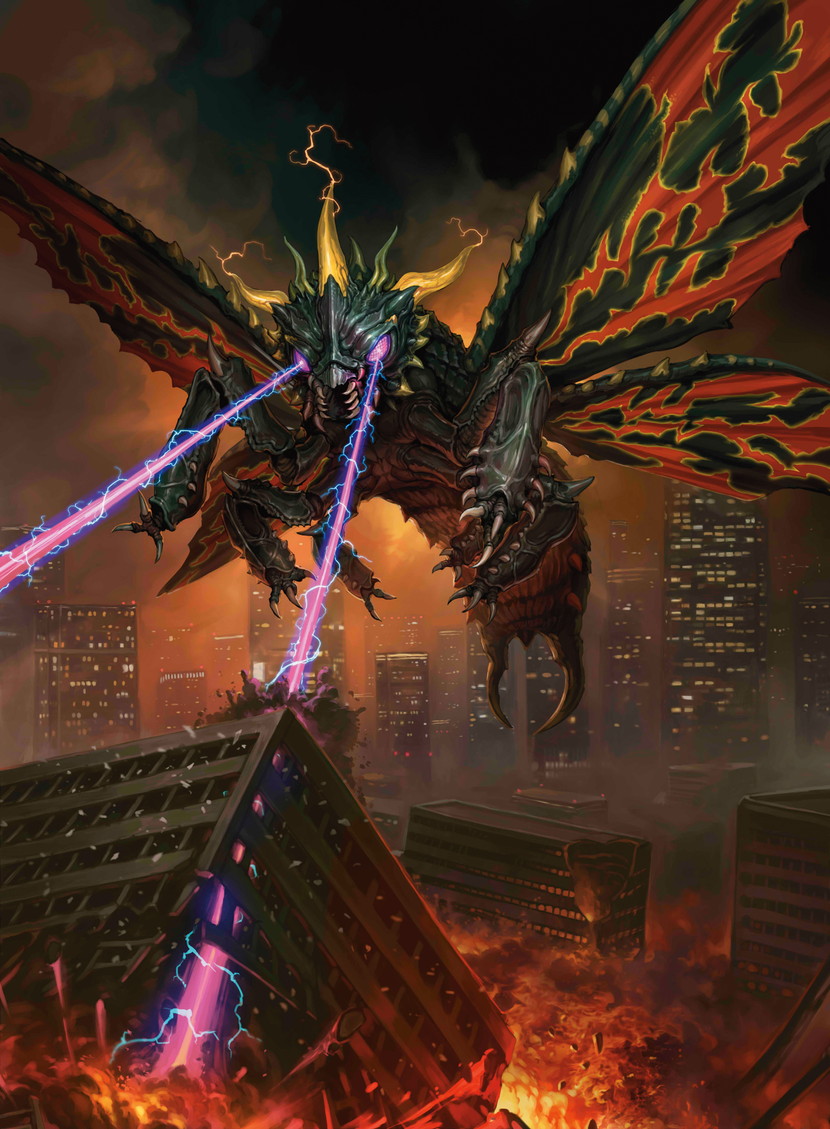
Battra, Dark Destroyer (Dirge Bat) by Kohei Hayama
Battra
Cards: Battra, Dark Destroyer (Dirge Bat)
Notable Appearances: Godzilla vs. Mothra (1992)
Battra is the answer to the question no one asked, "What if Mothra was genocidal?" Battra only appears in the Heisei era, where he was an evil Mothra created by mother nature to wipe out human civilization in the ancient past. Mothra was not happy with this, and she sealed Battra away. Battra was awakened in the 90's, where he clashed with Mothra until they were both forced to team up against Godzilla. Battra ultimately sacrificed his life to save Mothra.
Destroyah
Cards: Destroyah, Perfect Lifeform (Everquill Phoenix)
Notable Appearances: Godzilla vs. Destroyah (1995)
Way back in the original Godzilla, a scientist named Dr. Serizawa killed Godzilla and himself by unleashing a weapon he called the Oxygen Destroyer. The unintended side effect of the weapon mutated ancient crustaceans who merged (much like Ikoria's monsters) to become the massive and horrible Destroyah. Destroyah had several forms, but the one we see here is the final form. Destroyah was the final foe of the Heisei era Godzilla, and was by far one of the strongest monsters he has ever faced. Destroyah is one of my favorite Godzilla antagonists, and I even have a 'cute' plushie of him.
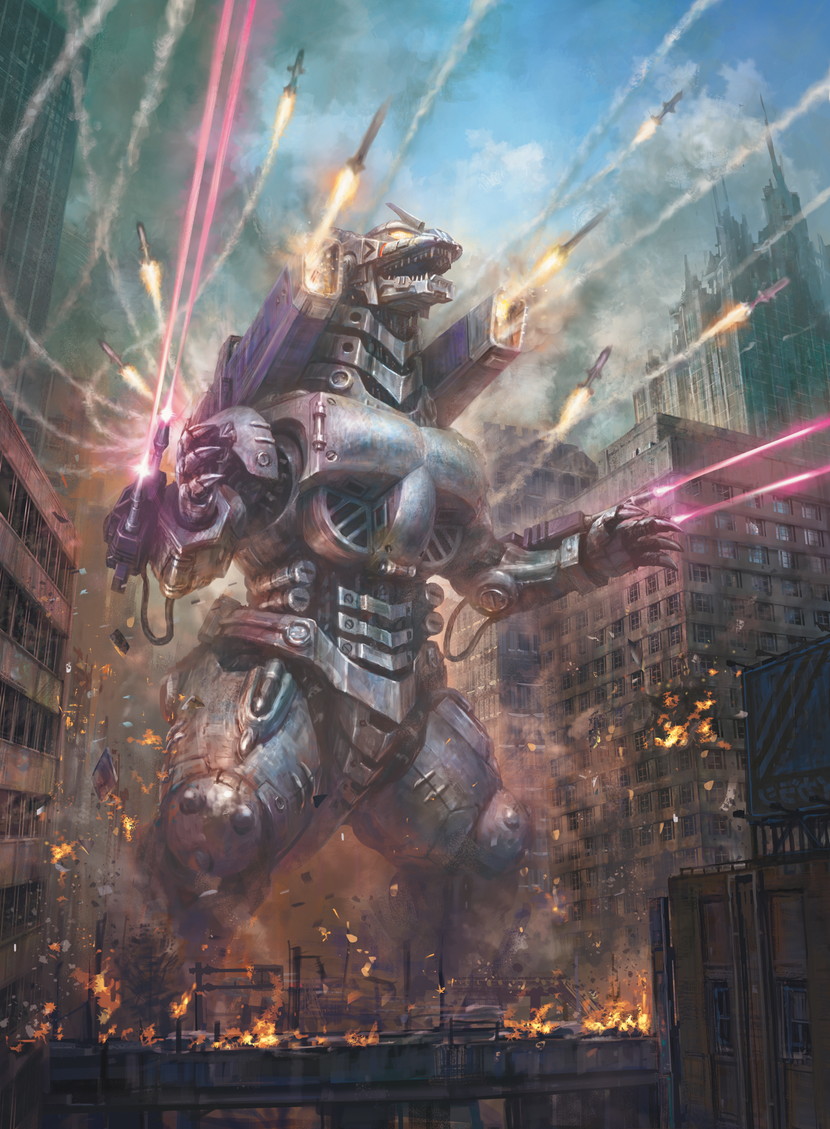
Mechagodzilla, the Weapon (Crystalline Giant) by KOTAKAN
Mechagodzilla III aka Kiryu
Cards: Mechagodzilla (Crystalline Giant)
Notable Appearances: Godzilla Against Mechagodzilla (2002), Godzilla: Tokyo SOS (2003)
This one was a shocker to me. I wasn't expecting artifact creatures on Ikoria. Mechagodzilla has had very different forms and origins over the years. The original Showa era Mechagodzilla was an alien weapon that was disguised as Godzilla. That version was created by aliens to frame Godzilla for Godzilla crimes. The Heisei era Mechagodzilla was a human giant robot created using, in part, future technology (if I recall correctly, technology obtained from Mecha King Ghidora). The version we see here is the Millennium era Mechagodzilla, also known as Kiryu (and sometimes Mechagodzilla III, even though the three designs are from different continuities).
Kiryu is from the only two Millenium Godzilla films to be in continuity with each other (they're both listed above in notable appearances). In this continuity, unlike most, the original Godzilla was killed in the 1954 film and leaves behind bones. When a new Godzilla emerges, Japan builds a Mechagodzilla using the original Mechagodzilla's bones as a frame. The original Godzilla's spirit still inhabited the machine, though, and would sometimes take control and rampage or disobey orders to kill Godzilla. The duology ended with Kiryu sacrificing itself to return Godzilla to the depths of the ocean rather than kill him.
Time to Go Go, Godzilla
Thanks everyone for sticking around and reading my huge Godzilla article. If you want to know more, Wikizilla is an excellent resource and I used it a few times when I had to jog my memory of the films. These Godzilla variants are the most I've ever wanted Magic cards, and I hope you find them as special as I do.














